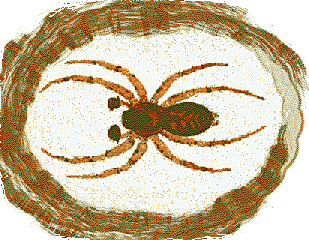

I have occasionally taken this species in pitfall traps, so it does go down on the ground, and it is sometimes found in leaf litter. However, it is on the trunks of the trees that you can find it in greatest numbers, hiding under the bark. Quite a contrast to last month's Walckenaeria acuminata, which is very much a leaf litter species - we're moving up into the trees this month.
A good way to catch tree-trunk spiders is to wrap corrugated paper around
the trunk; a 20-30cm wide strip wrapped twice around works well and a nail
or two into the trunk under the paper strip can stop it sliding down. The
animals move into the spaces in the corrugated paper and make their homes
there.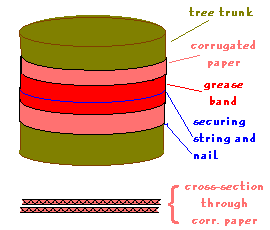 After several days (anything from a week to a month) you can carefully
remove the paper from the tree and put it securely in a plastic bag for
transport back to the laboratory where the spiders can be removed for identification.
An additional ploy is to wrap a sticky trap (like the grease bands used
on trunks of fruit trees) on top of the corrugated paper. You can then
distinguish between those spiders living under the bark and those moving
around on the outer surface.
After several days (anything from a week to a month) you can carefully
remove the paper from the tree and put it securely in a plastic bag for
transport back to the laboratory where the spiders can be removed for identification.
An additional ploy is to wrap a sticky trap (like the grease bands used
on trunks of fruit trees) on top of the corrugated paper. You can then
distinguish between those spiders living under the bark and those moving
around on the outer surface.
We used these kinds of traps during the winter months of 1971-72 to
sample tree-trunk spiders on the island of Inchcailloch (Loch Lomond) which
has some beautiful woods with a variety of tree species including oak, birch and
Scots pine. Cryphoeca silvicola was the dominant species
in the trapped assemblages, which comprised some 20 species. The second
most abundant of these species was Amaurobius fenestralis, congener
of our spider for November, A. similis, and to our surprise in the
following spring, one specimen of A. similis was found in a corrugated
paper trap.
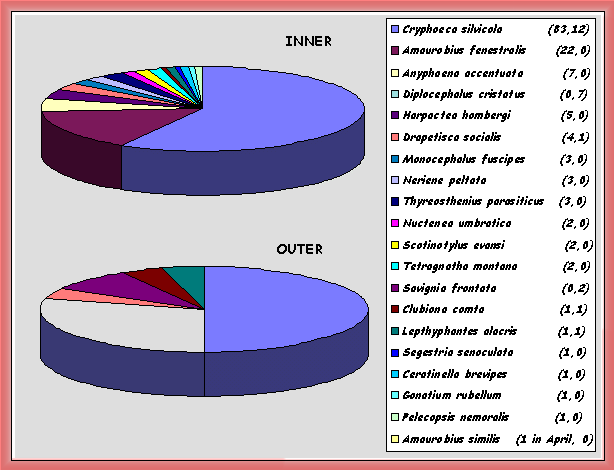
The pie-charts show the abundances of the "top 20" - the more abundant species which we recorded, listed in order of numerical abundance. The number of spiders caught during that winter are indicated in brackets after their names (inner, outer) and you can see the relative abundances within the shelter of the bark trap compared with the outer surface. Only two of these species (both linyphiines: D. cristatus, S. frontata) were taken on the outer trap and not inside.
Although, as usual in this part of the world a majority of species belong to the sheet-weavers, Linyphiidae (11 species: Diplocephalus cristatus, Drapetisca socialis,Thyreosthenius parasiticus, Monocephalus fuscipes, Neriene peltata, Savignia frontata, Scotinotylus evansi, Lepthyphantes alacris, Ceratinella brevipes, Gonatium rubellum and Pelecopsis nemoralis), it is interesting just how many different families are represented: Agelenidae which spin cobwebs or funnel webs (Cryphoeca silvicola), the cribellate Amaurobiidae (A. fenestralis and A. similis), Dysderidae (Harpactea hombergi), Anyphaenidae (Anyphaena accentuata), Clubionidae (Clubiona comta), Segestriidae (Segestria senoculata), and the orb-weavers Tetragnathidae (Tetragnatha montana) and Araneidae (Nuctenea umbraticola).
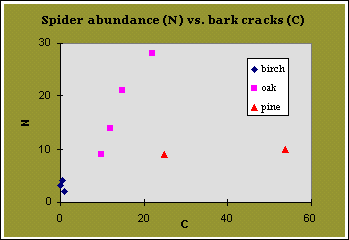
Interestingly, spider abundance varied between the three tree species
(oak > Scots pine > birch). The number of spiders also seemed to depend
on the amount of cracks in the bark of the trees. We measured the latter
as the area of cracks in a 20x20cm quadrat of the trunk at the position
of the paper trap. These relationships are shown in this graph (click on
it for source).
The linyphiids are generally small spiders, the species here having a size range from 1.3 to 4 mm. C. silvicola is of similar size, but the members of the other families are generally larger in the range 3 to 14 mm. The largest species here is N. umbraticola, a most impressive spider as you can see in this picture.
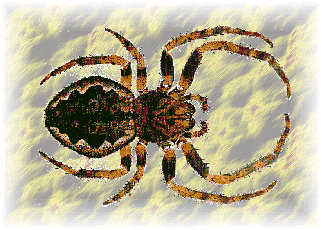 It
is an interesting spider:- although it is the largest of our species here
in terms of length (up to 14 mm), it is well adapted for the sheltered
habitat under tree bark by being dorso-ventrally flattened, with a depth
of only about 2 or 3 mm. In general terms, it is easily envisaged as coin-shaped,
being round in appearance from the top, but very flat from the side.
It
is an interesting spider:- although it is the largest of our species here
in terms of length (up to 14 mm), it is well adapted for the sheltered
habitat under tree bark by being dorso-ventrally flattened, with a depth
of only about 2 or 3 mm. In general terms, it is easily envisaged as coin-shaped,
being round in appearance from the top, but very flat from the side.
Its old name, before revision, was Araneus umbraticus, which
can be translated either as "spider of the shadows" referring to its habitat,
or as "shadowy spider" if you like, as a reminder of its flat shape!
.
The pictures of C. silvicola and N. umbraticola are adapted
from Dr. Mike Roberts' book : The Spiders of Great Britain and
Ireland, published by Harley Books in 1985.
| Return to..? | |
 Ariadne Home Page
Ariadne Home Page |
|